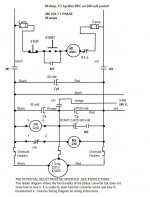BadDog
Stainless
- Joined
- Mar 27, 2006
- Location
- Phoenix, AZ
Ok, first off, I lucked up on a (seemingly so far) very nice 10hp Baldor Industrial "Inverter Duty" motor. This is a sealed case motor, like I want in 2hp for my Grinder. But in any case, the bearings are smooth as silk, and I got it for less than $50.
So, please comment as needed on my general statements. If I'm wrong, please correct/explain in common terms as I am by no means an electrician.
So, after reading quite a bit, and building on what I (hope I) learned with my first 3hp RPC, and trying to merge ToolNuts sketch (below) with my (hopefully) growing understanding, this is what I'm coming to (think I) understand...
Step 1:
Starting with my current functional 3hp GE motor based RPC. I first need to expand my small junction block for a larger "break out" box where it merges with my shop 3ph circuit. All current systems still work, and I can easily build up the extra parts as convenient/necessary.
Step 2:
Modify the contents of this box so that it will now contain additional contactors for controlling which converters are currently "on-line". Since I want to do any combination (3hp, 10hp, 10+3), I need a pair of 3ph contactors there, one for each of the 2 idler circuits.
Add 3 cover switches. 1 to start the 3 hp RPC, 1 to engage the 3hp contactor, and 1 to engage the 10hp contactor.
Now, the "heaters" and run-caps would go behind the relay/contactors so that each is used only when the specific idler is in use. Likewise each load motor would have it's own dedicated heaters.
The 1ph 220V T1/T2/N/G tie into the common distribution buss as shown in ToolNuts sketch. These, plus the generated phase from the idler contactors, feed the shop circuit.
Usage:
1) Light the 3hp motor with the Start switch.
2) Engage the 3hp contactor to generate L3 on the common bus.
3) Run any of the small shop machines (ranging from 1 to 2 hp.
4) If I want to run my 7.5hp lathe, throw the switch to engage the 10hp contactor and light the big idler. No start circuit needed because I have L3 from the 3hp Idler. The 3hp switch can be left on or not, probably off since the 10hp should run things just fine for my needs. Turning it off requires both switching the "Start" and "3hp" to "off. But if I need to start the 7.5 on max rpm with a heavy load (chucks/part), then may need both.
5) Shut down is as simple as placing all switches in off position.
Obvious improvements are possible with more complex circuits, but this seems the simple first steps.

So, please comment as needed on my general statements. If I'm wrong, please correct/explain in common terms as I am by no means an electrician.
So, after reading quite a bit, and building on what I (hope I) learned with my first 3hp RPC, and trying to merge ToolNuts sketch (below) with my (hopefully) growing understanding, this is what I'm coming to (think I) understand...
Step 1:
Starting with my current functional 3hp GE motor based RPC. I first need to expand my small junction block for a larger "break out" box where it merges with my shop 3ph circuit. All current systems still work, and I can easily build up the extra parts as convenient/necessary.
Step 2:
Modify the contents of this box so that it will now contain additional contactors for controlling which converters are currently "on-line". Since I want to do any combination (3hp, 10hp, 10+3), I need a pair of 3ph contactors there, one for each of the 2 idler circuits.
Add 3 cover switches. 1 to start the 3 hp RPC, 1 to engage the 3hp contactor, and 1 to engage the 10hp contactor.
Now, the "heaters" and run-caps would go behind the relay/contactors so that each is used only when the specific idler is in use. Likewise each load motor would have it's own dedicated heaters.
The 1ph 220V T1/T2/N/G tie into the common distribution buss as shown in ToolNuts sketch. These, plus the generated phase from the idler contactors, feed the shop circuit.
Usage:
1) Light the 3hp motor with the Start switch.
2) Engage the 3hp contactor to generate L3 on the common bus.
3) Run any of the small shop machines (ranging from 1 to 2 hp.
4) If I want to run my 7.5hp lathe, throw the switch to engage the 10hp contactor and light the big idler. No start circuit needed because I have L3 from the 3hp Idler. The 3hp switch can be left on or not, probably off since the 10hp should run things just fine for my needs. Turning it off requires both switching the "Start" and "3hp" to "off. But if I need to start the 7.5 on max rpm with a heavy load (chucks/part), then may need both.
5) Shut down is as simple as placing all switches in off position.
Obvious improvements are possible with more complex circuits, but this seems the simple first steps.



